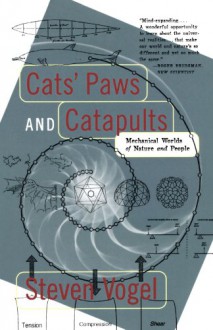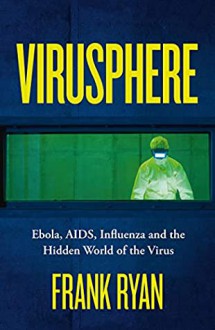

Schilthuizen takes a look at how the urban environment influences the evolution of animals and plants. He shows that evolution can happen rather quickly, within a few generations, rather than over thousands of years. He also shows that humans are a part of the environment and not separate from it. Each chapter is fairly short with numerous fascinating examples, making this a quick and interesting reading experience. Also recommended: Inheritors of the Earth: How Nature Is Thriving in an Age of Extinction by Chris D. Thomas

TITLE: Cats’ Paws and Catapults: Mechanical Worlds of Nature and People
AUTHOR: Steven Vogel
DATE PUBLISHED: 2000
FORMAT: Paperback
ISBN-13: 9780393319903
__________________________
DESCRIPTION:
"Nature and humans build their devices with the same earthly materials and use them in the same air and water, pulled by the same gravity. Why, then, do their designs diverge so sharply? Humans, for instance, love right angles, while nature's angles are rarely right and usually rounded. Our technology goes around on wheels—and on rotating pulleys, gears, shafts, and cams—yet in nature only the tiny propellers of bacteria spin as true wheels. Our hinges turn because hard parts slide around each other, whereas nature's hinges (a rabbit's ear, for example) more often swing by bending flexible materials. In this marvelously surprising, witty book, Steven Vogel compares these two mechanical worlds, introduces the reader to his field of biomechanics, and explains how the nexus of physical law, size, and convenience of construction determine the designs of both people and nature. "
__________________________
REVIEW:
This is an interesting and informative, scholarly, comparative overview of the difference between the way nature and humans engineer and manufacture things, the differences in the substances each uses to make those things, and the possibilities of why man and nature make things differently. Vogel has a clear, easy to understand writing style and provides many examples and diagrams to illustrate a point.
Other books:
~How to Walk on Water and Climb Up Walls: Animal Movement and the Robots of the Future by David L. Hu
~The Gecko’s Foot: How Scientists are Taking a Leaf from Nature's Book by Peter Forbes

TITLE: Virusphere: From common colds to Ebola epidemics – why we need the viruses that plague us
AUTHOR: Frank Ryan
PUBLICATION DATE: 2020
FORMAT: Paperback
ISBN-13: 9780008296704
___________________________
DESCRIPTION:
"A fascinating and long overdue examination of viruses – from what they are and what they do, to the vital role they have played in human history.
What are viruses? Do they rely on genes, like all other forms of life? Do they follow the same patterns of evolution as plants and animals?
Frank Ryan answers these questions and many more in a sweeping tour of illnesses caused by viruses. For example, the common cold, measles, chicken pox, herpes and mumps, rubella, as well as less familiar examples, such as rabies, ‘breakbone’ fever, haemorrhagic fevers like Ebola, and virus-induced cancers. Along the way, readers will learn about the behaviours and ultimate goals of viruses, gaining a deeper understanding of their importance in relation to the origins and the evolution of life, as well as they ways viruses have changed us at the most intimate level, to help make us quintessentially human."
_______________________________
REVIEW:
Rating: Not quite 4 stars but more than 3.5 stars
Virusphere is an introductory text to viruses - the diseases they cause and how they cause these diseases, their evolution, how they "live", how they influence the evolution of other species by messing around with other genomes, and how viruses form part of the Earth's ecosystem. This book starts off by providing a broad survey of a variety of the more common viral diseases ( e.g. measles, flu, cancer viruses etc), as well as the ones generally covered in other disease books such as insect-borne viruses, small pox and HIV/AIDS. I found the second half of the book more interesting as it covers giant viruses (mimiviruses), viral abundance everywhere including Antarctica, how viruses prey on bacteria, virus-wasp symbiosis, and how viruses alter the genomes of other species and influence that species evolution (e.g. retroviral genes in mammal genomes make it possible for placentas to develop properly - no virus, no mammals!). The chapter on the various hypotheses of viral evolution was also particularly interesting.
This is an interesting, informative and short overview of nearly everything virus, written in an engaging and intelligible manner.

TITLE: Eye of the Shoal: A Fishwatcher's Guide to Life, the Ocean and Everything
AUTHOR: Helen Scales
PUBLICATION DATE: 2020
FORMAT: Paperback
ISBN-13: 9781472936820
____________________
DESCRIPTION:
"Wild fish hover in seas, rivers and lakes, out of sight and out of mind. But from the very first time Helen Scales immersed herself into their liquid world, she realized that fish are beautiful, mesmerizing, complex and exciting. The moment she sank down to eyeball a wild trout--the fish poised in front of her, expertly occupying the three-dimensional space in a way that she could only dream of imitating--sparked the ichthyologist within, and set in motion years of study and exploration in the fishes' unseen domain as she became a devoted fish-watcher.
In this book, Scales shares the secrets of fish, unhitching them from their reputation as cold, unknowable beasts and reinventing them as clever, emotional, singing, thoughtful creatures, and challenging readers to rethink these animals. She takes readers on an underwater journey to watch these creatures going about the hidden but glorious business of being a fish. Their way of life is radically different from our own, in part because they inhabit a buoyant, sticky fluid in which light, heat, gases and sound behave in odd ways. They've evolved many tactics to overcome these challenges, to become megastars of the life sun-aquatic. In doing so, these extraordinary animals tell us so much about the oceans and life itself. Our relationship with these scaly creatures goes much deeper than predator versus prey. Fish leave their mark on the human world.
As well as being a rich and entertaining read, this book will inspire readers to think again about these animals, and the seas, and to go out and appreciate the wildness and wonders of fish, whether through the glass walls of an aquarium or, better still, by gazing into the fishes' wild world and swimming through it."
______________________________
REVIEW:
This book provides a fascinating and enjoyable survey of the fishy world, from fish colours and illumination, what they see, to venoms, poisons, how and what they eat, their evolution, the sounds fish make and if they can think and feel (apparently this is an issue!!?). In addition, Helen Scales provides personal observations from her lifelong passion of fish watching, as well as interesting historical anecdotes and more recent fishy research. Each chapter is also followed by a fishy folk tale. The writing style is natural and easy to understand. This is a beautifully written and enjoyable book that celebrates the diversity of fish but minimizes the doom and gloom (e.g. conservation, pollution and over-fishing).
OTHER BOOKS:
- Squid Empire: The Rise and Fall of the Cephalopods by Danna Staaf
- What a Fish Knows: The Inner Lives of Our Underwater Cousins by Jonathan Balcombe
- Venomous: How Earth's Deadliest Creatures Mastered Biochemistry by Christie Wilcox
- Restless Creatures: The Story of Life in Ten Movements by Matt Wilkinson
- Spirals in Time: The Secret Life and Curious Afterlife of Seashells by Helen Scales
- Horseshoe Crab: Biography of a Survivor by Anthony D. Fredericks
- Sex, Drugs, and Sea Slime: The Oceans' Oddest Creatures and Why They Matter by Ellen Prager
- Kraken: The Curious, Exciting, and Slightly Disturbing Science of Squid by Wendy Williams
- Poseidon's Steed: The Story of Seahorses, from Myth to Reality by Helen Scales
- Witness to Extinction: How We Failed to Save the Yangtze River Dolphin by Samuel T. Turvey
- Voyage of the Turtle: In Pursuit of the Earth's Last Dinosaur by Carl Safina